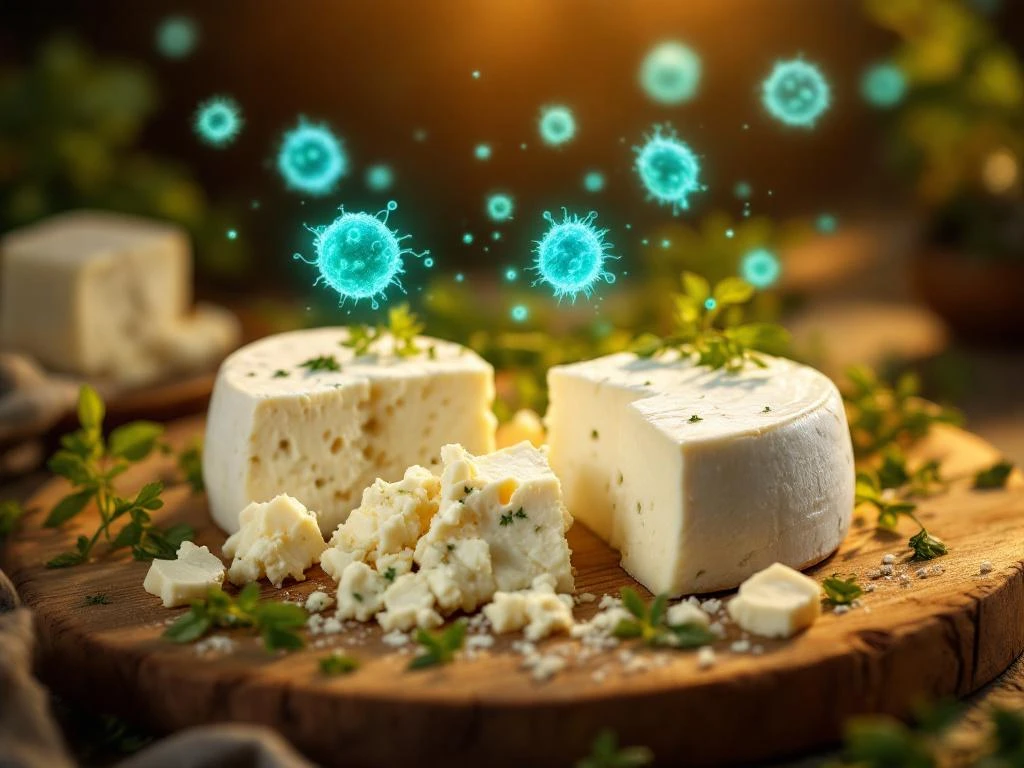Yes, goat cheese can contain probiotics, particularly in varieties that undergo traditional fermentation processes. The presence of beneficial bacteria depends largely on the production method, with fresh and aged goat cheeses typically containing live cultures that survive the cheese-making process. These probiotics develop naturally during fermentation when starter cultures transform milk into cheese, creating an environment where beneficial bacteria thrive.
Understanding probiotics in goat cheese production
Traditional goat cheese production inherently involves beneficial bacteria that play crucial roles in developing flavour, texture, and nutritional value. During the cheese-making process, starter cultures containing specific bacterial strains are added to goat’s milk, initiating fermentation. These cultures not only create the characteristic tangy flavour of goat cheese but also establish colonies of probiotics that can benefit digestive health.
The fermentation process in goat cheese production creates an ideal environment for probiotic development. As the milk transforms into cheese, lactic acid bacteria multiply and produce compounds that preserve the cheese whilst contributing to its unique taste profile. This natural preservation method has been used for centuries, long before we understood the health benefits of probiotics. For businesses in the cheese industry, understanding this process helps in selecting products that meet growing consumer demand for functional foods with digestive health benefits.
Does all goat cheese contain probiotics?
Not all goat cheese varieties contain active probiotics. Fresh goat cheese, ripened varieties, and traditionally made products typically retain beneficial bacteria, whilst heat-treated or heavily processed versions may have reduced or eliminated probiotic content. The key factor determining probiotic presence is whether the cheese undergoes pasteurisation after culturing and how it’s stored and handled throughout distribution.
Fresh goat cheese rolls and spreadable varieties often maintain higher probiotic levels because they undergo minimal processing after fermentation. Aged goat cheeses, including brie-style varieties, continue developing beneficial bacteria during the ripening process, creating complex flavour profiles alongside probiotic benefits. However, products subjected to high-temperature processing or extended shelf-life treatments may lose their probiotic activity. For industry wholesale buyers seeking probiotic-rich options, it’s essential to understand these processing differences when selecting products for health-conscious markets.
What types of probiotics are found in goat cheese?
Lactobacillus and Bifidobacterium species represent the primary probiotic strains found in goat cheese. These beneficial bacteria naturally occur during fermentation and contribute to both the cheese’s characteristics and its potential health benefits. Lactobacillus acidophilus, L. casei, and L. rhamnosus are commonly present in traditionally made goat cheeses, each offering specific digestive health advantages.
During cheese maturation, these probiotic strains perform multiple functions. They break down lactose, making goat cheese more digestible for sensitive individuals, produce antimicrobial compounds that extend shelf life naturally, and create bioactive peptides with potential health benefits. Additional strains like Streptococcus thermophilus and Lactococcus lactis work alongside primary probiotics, contributing to texture development and flavour complexity. Understanding these specific strains helps B2B buyers communicate the added value of probiotic-rich goat cheese to their customers.
How does the probiotic content in goat cheese compare to other dairy products?
Goat cheese typically contains probiotic levels comparable to yogurt and other fermented dairy products, with some varieties offering unique advantages. The smaller fat globules and different protein structure in goat’s milk create an environment where probiotics can thrive more readily than in cow’s milk cheese. This structural difference also makes goat cheese easier to digest, allowing probiotics to remain more active during digestion.
| Dairy Product | Typical Probiotic Content | Key Advantages |
|---|---|---|
| Fresh Goat Cheese | Moderate to High | Better digestibility, diverse strains |
| Aged Goat Cheese | Moderate | Stable probiotic activity, complex flavours |
| Yogurt | High | Standardised cultures, consistent levels |
| Cow’s Milk Cheese | Low to Moderate | Varies significantly by type |
The probiotic stability in goat cheese often surpasses that of liquid dairy products. Whilst yogurt may contain higher initial probiotic counts, the solid matrix of cheese protects beneficial bacteria during storage and digestion. This protection means that probiotics in goat cheese may have better survival rates when passing through stomach acid, potentially delivering more live cultures to the intestines where they provide benefits.
Which goat cheese varieties offer the highest probiotic benefits?
Fresh goat cheese varieties, including spreadable formats and crumbles, typically offer the highest probiotic benefits for B2B buyers. These minimally processed products retain maximum levels of live cultures from the initial fermentation. Aged varieties like goat brie and ripened rolls also provide substantial probiotic content, with the added advantage of extended shelf life and more complex flavour profiles that appeal to foodservice applications.
Raw milk goat cheeses, where permitted by regulations, contain the most diverse probiotic populations. However, traditionally made pasteurised varieties using careful temperature control can maintain excellent probiotic levels whilst meeting food safety requirements. For retail environments, portion-controlled formats like cheese pucks and pearls offer consistent probiotic delivery whilst providing convenience for consumers. Speciality cultured varieties developed specifically for enhanced probiotic content represent emerging opportunities for businesses targeting health-conscious market segments.
Key takeaways for B2B buyers seeking probiotic goat cheese
When sourcing probiotic-rich goat cheese, B2B buyers should prioritise products with minimal post-fermentation processing and proper cold chain management. Storage temperature significantly impacts probiotic viability, with consistent refrigeration below 4°C essential for maintaining live culture counts. Products with shorter distribution chains and faster turnover typically deliver higher probiotic activity to end consumers.
Market opportunities for probiotic goat cheese continue expanding as consumers increasingly seek functional foods. Retail buyers can capitalise on this trend by offering variety packs featuring different probiotic-rich formats, whilst foodservice operators benefit from versatile products suitable for both cold and warm applications. Understanding labelling requirements for probiotic claims and educating staff about proper handling ensures maximum value delivery. Consider partnering with suppliers who can provide technical support and documentation about probiotic content, helping you communicate these benefits effectively to health-conscious consumers seeking digestive wellness solutions through their dietary choices.
